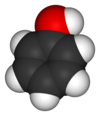| Phenol | |
|---|---|

|
|
| Systematic name | Phenol |
| Other names | Carbolic Acid Benzenol Phenylic Acid Hydroxybenzene |
| Chemical formula | C6H5OH |
| SMILES | OC1=CC=CC=C1 |
| Molar mass | 94.11 g/mol |
| Appearance | White Crystalline Solid |
| CAS number | [108-95-2] |
| Properties | |
| Density | 1.07 g/cm3 |
| Solubility in water | 8.3 g/100 ml (20 °C) |
| Melting point | 40.5 °C |
| Boiling point | 181.7 °C |
| Acidity (pKa) | 9.95 |
| Structure | |
| Molecular shape | planar |
| Dipole moment | ? D |
| Hazards | |
| MSDS | External MSDS |
| EU classification | Toxic (T) Muta. Cat. 3 Corrosive (C) |
| NFPA 704 |

2
4
0
|
| R-phrases |
R23/24/25,
R34, R48/23/24/25, R68 |
| S-phrases |
S1/2,
S24/25,
S26, S28, S36/37/39, S45 |
| Flash point | 79 °C |
| Autoignition temperature | 715 °C |
| RTECS number | SJ3325000 |
| Related compounds | |
| Related compounds | Benzenethiol |
Phenol, also known under an older name of carbolic acid, is a colourless crystalline solid with a typical sweet tarry odor. Its chemical formula is C6H5OH and its structure is that of a hydroxyl group (-OH) bonded to a phenyl ring; it is thus an aromatic compound.
Phenols
The word phenol is also used to refer to any compound which contains a six-membered aromatic ring, bonded directly to a hydroxyl group (-OH). In effect, phenols are a class of organic compounds of which the phenol discussed in this article is the simplest member.
Properties
Phenol has a limited solubility in water (8.3 g/100 ml). It is slightly acidic: the phenol molecule has weak tendencies to lose the H+ ion from the hydroxyl group, resulting in the highly water-soluble phenoxide anion C6H5O−. Compared to aliphatic alcohols, phenol shows much higher acidity,it even reacts with NaOH to lose H+ which aliphatic alcohols do not. This is due to orbital overlap between the oxygen's lone pairs and the aromatic system, which delocalizes the negative charge throughout the ring and stabilizes the anion. This effect is attenuated, however, due to oxygen's relatively high electronegativity. [1]
Production
Phenol can be made from the partial oxidation of benzene or benzoic acid, by the cumene process, or by the Raschig process. It can also be found as a product of coal oxidation.
Uses
Phenol has antiseptic properties, and was used by Sir Joseph Lister in his pioneering technique of antiseptic surgery, though the skin irritation caused by continual exposure to phenol eventually led to the substitution of aseptic (germ-free) techniques in surgery. It is one of the main components of the commercial antiseptic TCP (trichlorophenol).
Phenol has anesthetic properties, and is the active ingredient in some oral anesthetics such as Chloraseptic spray.
It is also used in the production of drugs (it is the starting material in the industrial production of aspirin), weedkiller, and synthetic resins (Bakelite, one of the first synthetic resins to be manufactured, is a polymer of phenol with formaldehyde). Exposure of the skin to concentrated phenol solutions causes chemical burns which may be severe; in laboratories where it is used, it is usually recommended that polyethylene glycol solution is kept available for washing off splashes. Washing with large amounts of plain water (most labs have a safety shower or eye-wash) and removal of contaminated clothing are required, and immediate ER treatment for large splashes; particularly if the phenol is mixed with chloroform (a commonly used mixture in molecular biology for DNA purification). Notwithstanding the effects of concentrated solutions, it is also used in cosmetic surgery as an exfoliant, to remove layers of dead skin. It is also used in phenolization, a surgical procedure used to treat an ingrown nail, in which it is applied to the toe to prevent regrowth of nails.
Injections of phenol have occasionally been used as a means of rapid execution.
Phenol was also used as a means of extermination by the Nazis during the Second World War. Phenol injections were given to thousands of people in concentration camps, especially at Auschwitz-Birkenau. Injections were administered either by medical doctors or by their assistants; such injections were originally given intravenously, more commonly in the arm, but injection directly into the heart, so as to induce nearly instant death, was later preferred. [2]
Phenols are extremely harmful to cats. [3]
References
- ^ The Acidity of Phenol. ChemGuide. Jim Clark. Retrieved on 2006-10-28.
- ^ Killing through phenol injection. Auschwitz - FINAL STATION EXTERMINATION. Johannes Kepler University, Linz, Austria. Retrieved on 2006-09-29.
- ^ Poison - hidden dangers?. Information for cat owners. Feline Advisory Bureau. Retrieved on 2006-09-29.




 216.73.216.81
216.73.216.81 User Stats:
User Stats:
 Today: 0
Today: 0 Yesterday: 0
Yesterday: 0 This Month: 0
This Month: 0 This Year: 0
This Year: 0 Total Users: 117
Total Users: 117 New Members:
New Members:
 216.73.xxx.xx
216.73.xxx.xx
 Server Time:
Server Time:

